When I was 9 years old, my father chartered a catboat from a local boat yard in Maine. My memory of that sail is vague, but many years later when I became an avid catboat aficionado, my family would remind me of it. The following is the story of how I evolved into a catboat sailor and builder.

My father introduced my brother, sister and me to sailing sloops in the early 1960s. When my brother and I were 3 and 2 years old respectively, he would strap us below in his 28-foot King’s Cruiser sloop and set sail for Maine from Plymouth, Massachusetts. In our early years of elementary school, he purchased a second-hand 32-foot fiberglass ketch after losing his King’s Cruiser in a hurricane. A few years later, he was able to buy the boat of his dreams, a used 42-foot shoal-draft, wooden ketch. From the beginning, he had set a goal to learn all that he could about sailing offshore and exploring ports he dreamt of and read about in the stacks of National Geographics in our home. So the journey began. All school vacations were sailing trips. We sailed south in the fall and north in the spring by way of the inner coastal waterway and eventually made our way offshore. This was training for my father’s ultimate goal of sailing with his family around the world.
So like many kids with sailing parents, my destiny was written at an early age: I would learn to love to sail. I am very grateful for the experiences my father shared with us and the trips I had as his crew or as skipper on his and other boats. There were many learning experiences that for a young kid became a way of life. The following is a random stream of sailing memories:
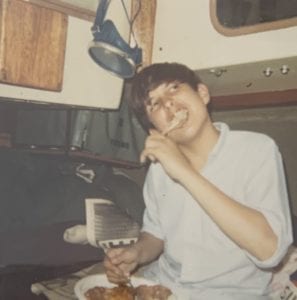
many offshore trips to the Bahamas; six years cruising the Bahamas in the early 70’s; surviving two serious lightning strikes while anchored; one harrowing night in a lightning storm underway in thick fog; tossing stored extra fuel over the side; countless squall lines with winds gusting 50 knots or more; snow storms at sea; frozen decks; crew members vomiting all over themselves and the boat; crew members curled up in a ball hard against a lee cloth reciting the lord’s prayer while in a gale; riding out a hurricane in the Azores chained to a harbor buoy because the holding ground was so poor; experiencing a full gale off Hatteras; bartering a bottle of whiskey with a village chief in Gambia, Africa, for the use of his motorcycle and then heading off into the forest to Dakar, Senegal, looking for a part we needed; being mobbed by young villagers who had never seen a white person; a full-on knock-down 120 miles offshore on a racing yacht, unsure for a moment if she would come back as we hung in the water from our harnesses; many groundings and nights spent on a sand bar; making landfall into the port of Crooks-Haven, Ireland, in pea soup fog, having left the Azores eleven days earlier with the wrong charts, only a road map to get us in safely; our rental car stolen by the IRA, and then hitch hiking and sleeping by the side of the road trying to get from Dublin back to the boat; going overboard while under way in the frigid cold Irish sea to free up a fishing line that had wrapped around the prop; on a number of occasions having to climb the main mast in a storm to retrieve a lost halyard; slipping over the side from a freak wave in the middle of the night while changing a sail in the south Atlantic, the safety harness allowing me to pull myself back aboard; feeling like I was going to die after leaving the Verde Islands with food poisoning that hit me after we were underway; coming within feet of hitting a reef on a late night landfall off Grand Bahama in strong winds and following seas, (we accidentally mistook a range light for a light in a beach shack); many fire drills when squalls came through a crowded anchorage in the dark of night; boats dragging into other boats and banging and colliding as a wall of rocks or a beach would be our landing if we did not act quickly untangling the anchor rodes; a full gale in the Gulf of Maine returning from Nova Scotia in a wooden 120 schooner, three reefs in the main and a reef in the fore doing 11 knots in a following sea; nearly missing the Galapagos Islands due to a navigational error; being in the engine room in a full gale, checking the transmission because it was getting hot from the prop freely spinning as we raced down the waves and then in horror seeing the shaft get so hot that it released from the transmission, instantly expecting to be sinking within seconds, ordering the crew to grab the wooden plugs to fill the shaft log, miraculously the shaft stopped, saved by the shaft zinc, securing against the shaft strut; while trade wind sailing in 20 knots of breeze sadly hitting a sleeping whale, sending a shudder through the wooden boat that concerned everyone that there might be a major leak, but there wasn’t; my father never checking the weather forecast before heading out on a trip, he felt if he did there would be good chance we would not go and that would mess up his schedule as he juggled work and sailing time; rebuilding motor parts for the engine and systems the best we could on beaches and in random island villages in remote places that had no service or parts;
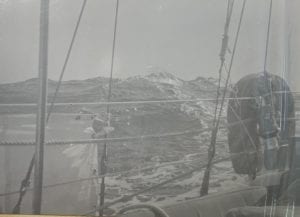
a wild flight aboard a twin prop plane flying to a key in the Bahamas from Florida where the boat had been left, the pilot telling us halfway into the flight that we were over the weight limit and going down if we did not toss our gear out of the plane to lighten her up, which we did, later learning that the plane was loaded with contraband and the pilot had not calculated all the provisioning we had brought from the states; on another trip, the charter company seaplane starting to sink after landing near our boat; breaking my nose when going forward to secure a loose anchor as the boat lifted from a sea, having lost my grip, being tossed into the air and landing on the deck nose first, blood splattered everywhere; keeping a loaded shot gun aboard and practicing to use it when at sea in the event we were to be boarded by pirates; returning to the boat after leaving her in the Turks and Caicos for three months to find she had been stripped clean of all valuable gear by thieves; being boarded by custom agents with guns drawn in Agadir, Africa, and having our passports taken and sensing if we did not give the agents all of our liquor, or whatever else they wanted, we were not getting out of there alive; letting the crew down when a serious squall line came through while crossing the English Channel and after sailing through it, we realized we had lost a bagged working jib, which I had been supposed to secure properly.

Then, there are the not-so-dramatic memories: trade wind passages that went well; endless beautiful sunrises and sunsets, moonrises and sets; catching fish with ease for dinner; working with the stars above to confirm your course; expecting and planning for the slow-moving weather days, and taking advantage to do repairs and boat maintenance duties; experiencing the doldrums or days of flat calm hundreds of miles from land; watching all the life below the surface coming and going including dolphins, porpoises, whales, sharks, turtles and the occasional tired bird hitching a ride; the flying fish all over the deck after a night of sailing to windward; staring over the side at night being mesmerized by the phosphorescent lights; the symphony of sounds, laying in your bunk listening to the wooden boat in motion, the waves interrupted by the hull working her way through them; the spectacular landfalls, sighting land on the far horizon and thinking I am happiest at sea and would prefer to let the land go by; learning the culture of the people of the new island or continent, their habitat and the beauty of the their way of life; diving on reefs and swimming in crystal clear water; the shore parties after a long passage; the satisfaction after hours of work, cleaning, fixing, polishing, varnishing and painting the boat to keep her safe and seaworthy; receiving gifts, like a live chicken from a village Chief that expected us to slaughter and eat it, instead we named it Dinner and made it our pet letting it run loose around the boat; provisioning, and the fun adventures that happened when trying to find a ride and the needed provisions; the bonding amongst the crew, hours on watch, and the friendships that develop and last a lifetime; the team work that makes a potentially bad situation ultimately work out because everyone knew their job and worked together; the appreciation of living in close quarters and learning to respect each other’s space and the wants and needs of others; learning to avoid confrontation through patience, when situations are tough and personalities are clashing; learning to be diplomatic and expecting everyone to carry equal weight; the times you are in your bunk exhausted and you think you have another hour or two of rest and hear “sail change, all hands on deck,” jumping to get there.
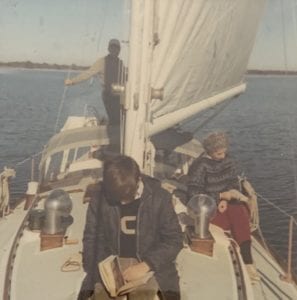 All of this would not have been possible without a father who had a dream as a young man to travel the world by boat and share the experiences with his family. For me, it was extra special because I learned that the tough side of my father was intended to make me a better person. In hindsight, I now realize that some of the more difficult moments we had were meant to be building blocks for me to mature and grow at sea, by way of many meaningful and rewarding experiences. There are many more stories I experienced with my father, as well as on other boats, that made sailing seem like a big wild adventure. But it was how I was brought up to sail, expecting the unexpected at all times, that’s what made the trips unique.
All of this would not have been possible without a father who had a dream as a young man to travel the world by boat and share the experiences with his family. For me, it was extra special because I learned that the tough side of my father was intended to make me a better person. In hindsight, I now realize that some of the more difficult moments we had were meant to be building blocks for me to mature and grow at sea, by way of many meaningful and rewarding experiences. There are many more stories I experienced with my father, as well as on other boats, that made sailing seem like a big wild adventure. But it was how I was brought up to sail, expecting the unexpected at all times, that’s what made the trips unique.
When I was in my late teens/early twenties, almost all of these experiences were in my past and a new opportunity presented itself to me: to learn the trade of building a wooden boat. I took the offer and settled in Maine for four years to pursue my version of a college education. I worked side by side as an apprentice to Arno Day, a fourth generation boat builder and a true master of his craft. When the apprenticeship ended, I sailed south in a 28-foot cutter that Arno and I had built together. I earned a living working in various boatyards as far south as Long Island. Eventually, I ended up in the Charlestown Navy Yard in Boston building boats, where I settled down and started a family. After three years in Boston, my wife and I realized the city was not for us, so we started looking for a boat building business.
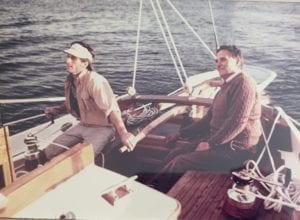 A good friend, who was a fifth generation Cape Codder and who I had met while helping to finish the interior on the 120 foot schooner, Spirit of Massachusetts, insisted that if I could get the financing, I should buy a boat yard in Orleans, Massachusetts, located on a beautiful bay with ocean access, which had just come on the market. The year was 1989, I was 31 and ready to commit to building a business. So we visited the boat yard and the owners were very nice and showed my wife, Robin, and me around. On one of our visits, the owners suggested I take their personal 14-foot catboat for a sail on the bay. I agreed and headed out alone on an exceptionally beautiful day. Prior to this, my only single-handed small boat experience had been occasionally sailing a 12-foot Cape Dory skiff in Maine when I was very young. I had no experience with a gaff rig, and I had been bitten by the myth that catboats were slow and could not sail to windward, so I was not expecting much of a sail. I used the outboard to get down a beautiful river, and once at the bay, I fumbled with the halyards trying to figure out what was what, but eventually I was able to raise the sail. Once underway, I kept trying to get the boat to heel and point, so I would tighten the sheet line. When I did, the boat would stall; she was not happy. I eased the sheet and let the sail fill, the rig relaxed, the sail filled with a pocket in the forward third of the sail and she began to move through the water like I wasn’t aboard. I sailed through this narrow spit of water separating a small bay from a bigger bay. It was challenging, beating into a southwest breeze that was building and kept me heading deeper into the bigger bay. With each tack and little adjustments to the halyards, I began to understand the rig. I also began to relax. There was an incredible sense of security on this little boat with its wide beam and rugged rig. I felt completely at ease. The boat was pointing to windward just fine. The waves grew bigger in the big bay, the little catboat was in her space, she would dig into each wave. The spray coming over the bow gave the small boat sailing experience a big boat feel. Being so close to the water, I was learning a whole new way to appreciate sailing.
A good friend, who was a fifth generation Cape Codder and who I had met while helping to finish the interior on the 120 foot schooner, Spirit of Massachusetts, insisted that if I could get the financing, I should buy a boat yard in Orleans, Massachusetts, located on a beautiful bay with ocean access, which had just come on the market. The year was 1989, I was 31 and ready to commit to building a business. So we visited the boat yard and the owners were very nice and showed my wife, Robin, and me around. On one of our visits, the owners suggested I take their personal 14-foot catboat for a sail on the bay. I agreed and headed out alone on an exceptionally beautiful day. Prior to this, my only single-handed small boat experience had been occasionally sailing a 12-foot Cape Dory skiff in Maine when I was very young. I had no experience with a gaff rig, and I had been bitten by the myth that catboats were slow and could not sail to windward, so I was not expecting much of a sail. I used the outboard to get down a beautiful river, and once at the bay, I fumbled with the halyards trying to figure out what was what, but eventually I was able to raise the sail. Once underway, I kept trying to get the boat to heel and point, so I would tighten the sheet line. When I did, the boat would stall; she was not happy. I eased the sheet and let the sail fill, the rig relaxed, the sail filled with a pocket in the forward third of the sail and she began to move through the water like I wasn’t aboard. I sailed through this narrow spit of water separating a small bay from a bigger bay. It was challenging, beating into a southwest breeze that was building and kept me heading deeper into the bigger bay. With each tack and little adjustments to the halyards, I began to understand the rig. I also began to relax. There was an incredible sense of security on this little boat with its wide beam and rugged rig. I felt completely at ease. The boat was pointing to windward just fine. The waves grew bigger in the big bay, the little catboat was in her space, she would dig into each wave. The spray coming over the bow gave the small boat sailing experience a big boat feel. Being so close to the water, I was learning a whole new way to appreciate sailing.
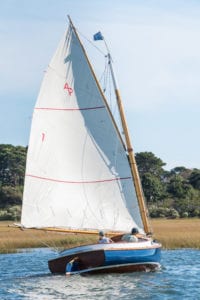
When it was time to head back, the wind was getting lighter but it was a run back to the river. I had the mainsheet all the way out and the boom ninety degrees to the mast with a little belly in the sail. I laid down on the bench seat and stared up at the crystal clear blue sky with a hand on the tiller. I felt totally at peace. The centerboard was up and the tide was going out and the little cat skated over 10″ of water with ease. I was surrounded by land with very little water under me. What was happening? I thought. What have I missed? Is this sailing? When I got back to the boatyard and returned the boat to the owner, I thanked him for the experience. I told him some words of wisdom a boat builder named Joel White conveyed to me when he knew I wanted to leave Maine to build boats. He said, “Remember, wherever you end up, the best boat to design and build are the boats that fit the waters you are sailing in.”
As days went by, I could not get that catboat sail out of my head; the memory of that sunlit sky, the shallow water that was so clear and clean, sailing flat and fast, the horseshoe crabs skirting about the sand as the boat approached them. It was as if the boat was taking me for a sail. It all seemed so simple in comparison to my years of sailing offshore, debating sail combinations on a sloop, cutter, schooner, ketch or yawl. When my short day sail was over, I still felt the same energy and adrenaline-high that I felt following an offshore experience. I was hooked on small boat sailing, something I had missed in my childhood.
One and half years later, in September of 1991, we closed on the purchase of Arey’s Pond Boat Yard. To this day, my team and I specialize in designing and building catboats and other shoal draft designs, and I never get tired of sailing on that bay.
